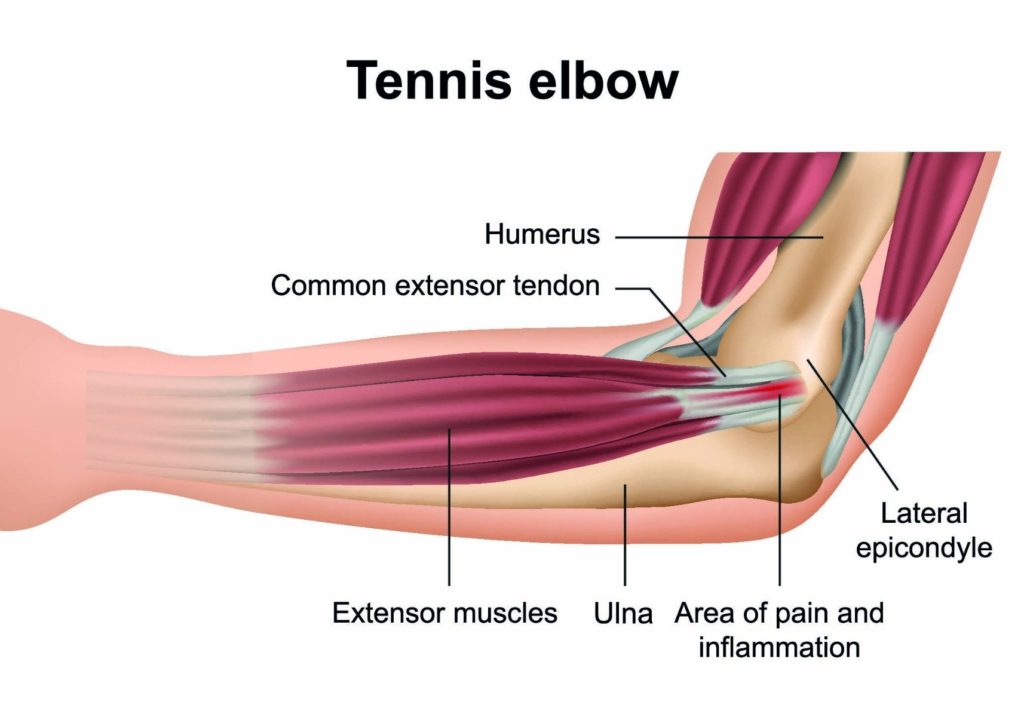09 Apr Tennis elbow

Tennis elbow is a generic (common usage) term for pain around the outside of the elbow. When a person gets tennis elbow, one or more of the tendons in their elbow becomes painful. The pain typically occurs at the point where the tendons of the forearm muscle attach to the bone, but it can also be felt into the upper forearm muscles.
Causes of Tennis Elbow
Tennis elbow is caused by irritation or damage of the tendons of the forearm due to overuse of the muscles or through a minor injury. Any activity that involves gripping and twisting of the forearm can cause this type of strain. At this time of year a common example of this type of activity is pruning or pulling weeds in the garden.
Anybody can get tennis elbow but it is most common in people between the ages of 40 and 60. It usually occurs with the start of a new repetitive activity, or with an increase in the amount of an activity undertaken. Though some studies say it normally recovers over time, often it can trouble for some time if not addressed early.
Symptoms of tennis elbow
The main symptom of tennis elbow is pain and tenderness on the outside of the elbow. You may also feel pain travelling down your forearm. Twisting movements, such as turning a door handle or opening the lid of a jar can be painful. As it worsens even very light activities can trouble.
Treatments of Tennis Elbow
Modify your activities
If possible stop the particular activity that causes pain, or find a different way of doing it, but also reduce the frequency or load of the activity. Try to avoid lifting, gripping or rotating the affected arm, and take regular breaks when doing painful activities. If you are involved in a sport/profession using repetitive movements, seek expert advice on your technique.
Using a tennis elbow band my be helpful for some people. Even if the brace works you still need to modify your activity level. Braces aim to decrease the tension on the tendon by using the pressure from the brace to stop all the force going in to the tendon. Wear it when you are using your arm and take it off at night/resting.
Exercises
Exercises are needed to restore the strength of the muscle and tendon. They are necessary both for it to heal and also to help prevent future episodes. See us for advice on what exercises are best for you. Stretching the muscle / tendon complex can help to restore movement and keep tension out of the corresponding muscles as it gets stronger.
Other treatments
Sometimes a corticosteroid injection may be given. However research shows this may give short term help but over the long term exercise is more beneficial. Acupuncture has also been shown to provide short term help. Shock wave therapy also has been shown to have a positive effect.
Pain relief
Taking painkillers may help to reduce mild pain that is caused by tennis elbow while you are undergoing treatment. Please seek advice from your GP or pharmacist regarding appropriate pain medication for you.
Recovery
Though tennis elbow is said to be self-limiting condition (most cases the symptoms eventually improve and clear up without treatment) this may take up to two years. Treatment is therefore recommended, not only to reduce pain and symptoms, but also to strengthen the areas as a preventative measure for the future. Seek advice from us as to how best manage your problem.


Sorry, the comment form is closed at this time.